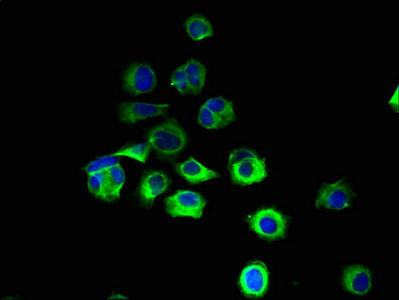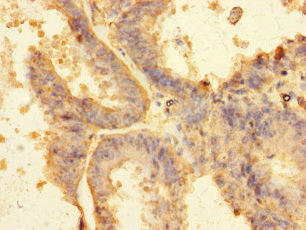Description
| Antibody Name: | RNF103 Antibody (PACO29532) |
| Antibody SKU: | PACO29532 |
| Size: | 50ug |
| Host Species: | Rabbit |
| Tested Applications: | ELISA, IHC, IF |
| Recommended Dilutions: | ELISA:1:2000-1:10000, IHC:1:20-1:200, IF:1:50-1:200 |
| Species Reactivity: | Human |
| Immunogen: | Recombinant Human E3 ubiquitin-protein ligase RNF103 protein (432-685AA) |
| Form: | Liquid |
| Storage Buffer: | Preservative: 0.03% Proclin 300 Constituents: 50% Glycerol, 0.01M PBS, PH 7.4 |
| Purification Method: | >95%, Protein G purified |
| Clonality: | Polyclonal |
| Isotype: | IgG |
| Conjugate: | Non-conjugated |
 | Immunofluorescent analysis of MCF-7 cells using PACO29532 at dilution of 1:100 and Alexa Fluor 488-congugated AffiniPure Goat Anti-Rabbit IgG(H+L). |
 | Immunohistochemistry of paraffin-embedded human breast cancer using PACO29532 at dilution of 1:100. |
 | Immunohistochemistry of paraffin-embedded human endometrial tissue using PACO29532 at dilution of 1:100. |
| Background: | Acts as an E2-dependent E3 ubiquitin-protein ligase, probably involved in the ER-associated protein degradation pathway. |
| Synonyms: | E3 ubiquitin-protein ligase RNF103 (EC 2.3.2.27) (KF-1) (hKF-1) (RING finger protein 103) (RING-type E3 ubiquitin transferase RNF103) (Zinc finger protein 103 homolog) (Zfp-103), RNF103, ZFP103 |
| UniProt Protein Function: | RNF103: Acts as an E2-dependent E3 ubiquitin-protein ligase, probably involved in the ER-associated protein degradation pathway.Protein type: EC 6.3.2.-; Membrane protein, multi-pass; Ubiquitin ligase; Ubiquitin conjugating system; Membrane protein, integral; EC 6.3.2.19Chromosomal Location of Human Ortholog: 2p11.2Cellular Component: endoplasmic reticulum; endoplasmic reticulum membrane; integral to membraneMolecular Function: ligase activity; protein binding; ubiquitin-protein ligase activity; zinc ion bindingBiological Process: central nervous system development; ER-associated protein catabolic process; protein ubiquitination |
| UniProt Protein Details: | |
| NCBI Summary: | The protein encoded by this gene contains a RING-H2 finger, a motif known to be involved in protein-protein and protein-DNA interactions. This gene is highly expressed in normal cerebellum, but not in the cerebral cortex. The expression of the rat counterpart in the frontal cortex and hippocampus was shown to be induced by elctroconvulsive treatment (ECT) as well as chronic antidepressant treatment, suggesting that this gene may be a molecular target for ECT and antidepressants. The protein is a ubiquitin ligase that functions in the endoplasmic reticulum-associated degradation pathway. Alternative splicing of this gene results in multiple transcript variants. Read-through transcription also exists between this gene and the downstream CHMP3 (charged multivesicular body protein 3) gene. [provided by RefSeq, Oct 2011] |
| UniProt Code: | O00237 |
| NCBI GenInfo Identifier: | 312147324 |
| NCBI Gene ID: | 7844 |
| NCBI Accession: | NP_001185880.1 |
| UniProt Secondary Accession: | O00237,Q53SU6, Q8IVB9, A6NFV6, B2RAG4 |
| UniProt Related Accession: | O00237 |
| Molecular Weight: | 79,405 Da |
| NCBI Full Name: | E3 ubiquitin-protein ligase RNF103 isoform 2 |
| NCBI Synonym Full Names: | ring finger protein 103 |
| NCBI Official Symbol: | RNF103 |
| NCBI Official Synonym Symbols: | KF1; KF-1; HKF-1; ZFP103; ZFP-103 |
| NCBI Protein Information: | E3 ubiquitin-protein ligase RNF103 |
| UniProt Protein Name: | E3 ubiquitin-protein ligase RNF103 |
| UniProt Synonym Protein Names: | KF-1; hKF-1; RING finger protein 103; Zinc finger protein 103 homolog; Zfp-103 |
| Protein Family: | E3 ubiquitin-protein ligase |
| UniProt Gene Name: | RNF103 |
| UniProt Entry Name: | RN103_HUMAN |






